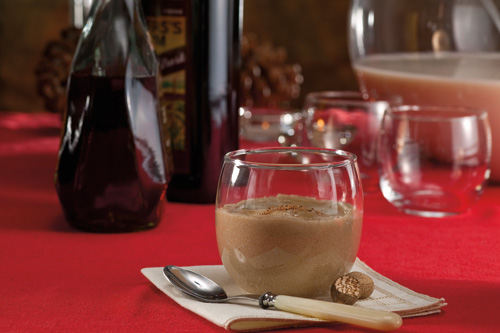 Photo courtesy of Ulysses Press; recipe reprinted with permission from Ice Cream Happy Hour (Ulysses Press).
Photo courtesy of Ulysses Press; recipe reprinted with permission from Ice Cream Happy Hour (Ulysses Press).
Everyone knows that the happiest hour is one that involves ice cream...but what about when the weather gets cold and you want to keep toasty?
The natural solution is Eggnog. And now that it's after Halloween, I say "it's time." As the book says,
One of the joys of egg nog is that it seems so innocent, with its egg yolks and spiced cream, and yet it has an almost devilish side of dark rum and brandy. This ice cream is as rich as it is flavorful, and it has enough rum and brandy to keep you happy through the holidays. And like any good egg nog, freshly grated nutmeg adds a special touch.
Eggnog with Brandy and Rum
Ingredients
- 1 cup milk
- 1¾ cups heavy cream
- pinch of salt
- 6 egg yolks
- ¾ cup sugar
- 2 teaspoons vanilla extract
- 1 teaspoon freshly grated nutmeg
- 1 packet (1 tablespoon) gelatin
- ⅓ cup cold water
- ⅓ cup cold (refrigerated) brandy
- ⅓ cup cold (refrigerated) dark rum
Makes about 1 quart
1. Scald the milk and cream with the salt; don’t add the sugar yet. Mix the milk, cream, and salt in a medium saucepan over medium low heat until the salt is dissolved. Continue heating until the mixture is steamy and makes a slight sizzling noise when you move the pan. This is called scalding.
2. Whisk the egg yolks and temper. Whisk the egg yolks with the sugar and temper with ⅓ cup of the scalding milk mixture. Gently stream about one-third of the hot milk mixture into the eggs while whisking continuously. This is called tempering. It’s important to whisk while streaming the hot milk. If you just pour in the hot milk and then whisk, you may get scrambled eggs.
3. Thicken the custard over low heat. Pour the egg and milk mixture into the rest of the milk mixture in the saucepan and stir continuously on low heat with a heatproof spatula. Make sure you scrape the bottom evenly while you continuously stir. The custard is thick enough when you can draw a line on the back of the spoon with your finger and the line retains its shape.
4. Whisk in the vanilla extract and nutmeg.
5. Strain, cover, and chill the custard for at least 8 hours. Strain the custard through a fine-mesh strainer into a heatproof container. Cover with plastic wrap so that it’s directly touching the entire surface of the custard and none of it is exposed to air. This prevents a skin from developing. Transfer the container to an ice bath and let it cool for about 30 minutes to stop the cooking process. Transfer the container to the refrigerator. Chill until the custard is completely cold, at least 8 hours. Once the custard is completely cold…
6. Dissolve the gelatin in the cold water. When the custard is cold and you’re ready to churn the ice cream, dissolve the gelatin. Pour the water into a small saucepan or microwave-safe container and evenly sprinkle the gelatin on top. Allow to sit until the gelatin appears to have absorbed as much water as it can, about 2 minutes. This is called blooming. Gently warm over low heat and stir until the gelatin is completely dissolved into the liquid, about 3 minutes. If using a microwave, heat on medium power and check every 30 seconds until the gelatin is completely dissolved. The total time will depend on the microwave’s voltage.
Note: It’s important that the gelatin gets completely dissolved at this stage. Once the alcohol is mixed in, the gelatin denatures and will never fully dissolve. However, once the alcohol is added, clumps may form. This is fine since in most cases you strain the gelatin mixture before adding it to the custard. Do not try to reheat the gelatin mixture once you’ve added the alcohol; this will only denature the gelatin further, making it unable to solidify the ice cream, and it will also cook off the alcohol.
7. Spike the custard with the cold brandy, dark rum, and gelatin mixture. Refrigerate the alcohol until completely cold. Do not speed up the process by putting it in the freezer, which may make the gelatin set up too much before it is added to the custard. Pour the gelatin into a medium bowl and whisk in the cold alcohol until combined. Do not attempt to skip this step by pouring the alcohol directly into the saucepan or microwave-safe container with the gelatin. There might be enough residual heat to heat up the custard and prevent it from thickening in the ice cream maker (we learned this the hard way). Pour the cold custard into a large bowl. Stream the alcohol and gelatin mixture through a fine-mesh strainer into the custard and whisk until thoroughly blended.
8. Churn the ice cream for at least 20 minutes. Pour the cold custard immediately into the ice cream maker and churn for at least 20 minutes, or as directed. Due to the alcohol content, you may wish to churn it longer to get the desired thickness. If you don’t want to serve the ice cream immediately, or you want a firmer texture, transfer it to a freezer-proof container and freeze for several hours before serving.
